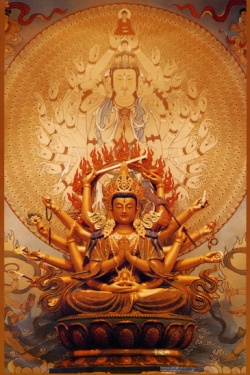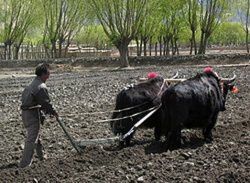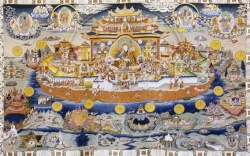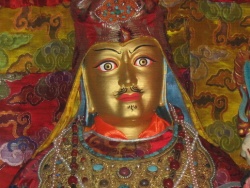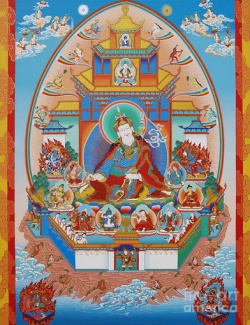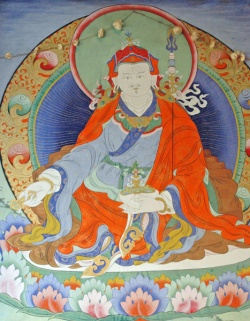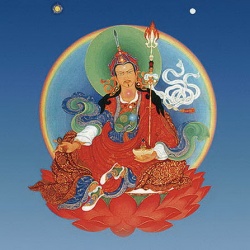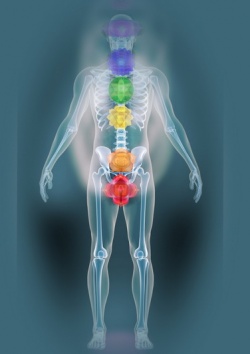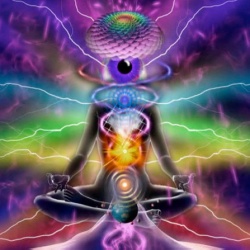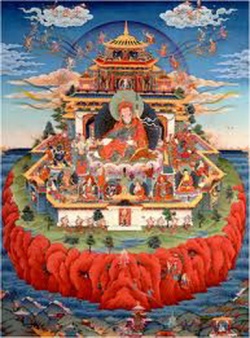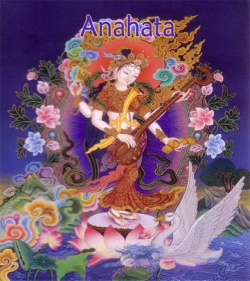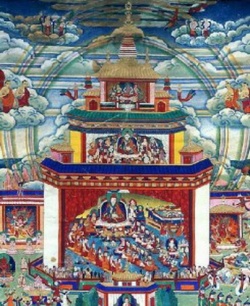What is the name of the place where the temple has been built?
Rinpoche, could you introduce us to the particular place where the temple has been built?
What is the name of the place where the temple has been built?
The ancient name of the place is Rabni Tang (in Tibetan: རབ་གནས་ཐང་།). It means « blessed area ». Some people say that it was blessed by Guru Rinpoche, some say by Jigme Lingpa. Nowadays the place is called Trashé Karmo Yangkhyil (in Tibetan: བཀྲ་ཤིས་དཀར་མོ་གཡང་།) which means « auspicious white wealth whorl ». I think this name was given by Kyapjé Pema Kelzang Rinpoche (in Tibetan: སྐྱབས་རྗེ་པདྨ་སྐལ་བཟང་རིན་པོ་ཆེ).
In Dzogchen there are a few sacred places. One of them is Shri Singha University . Another one is the place where Zangdok Palri is being built. It is of great importance because it can bring a lot of benefit in this decadent time.
Guru Rinpoche was in Dzogchen
A lot can be said about Dzogchen. There have been many great masters. One must check the history of Dzogchen Monastery to find out.
Guru Rinpoche stayed one year in Dzogchen. He practised the Medicine Buddha, and had accomplishments. When he finished there was a rain of seeds of a medicine plant, Arura. This plant is very important in Tibet from the medicinal point of view. Normally it can be found in India, but not in Tibet . Still nowadays, when you go to the top of the snow mountain in Dzogchen and search under the snow, you can find seeds of Arura.
How was this place chosen to build the Zangdok Palri Temple on?
These days the head, the main holder, of the Dzogchen Monastery is Kyapjé Pema Kelzang Rinpoche. He gives responsibilities and tasks to Tulkus. He gave me the task to create the image of Zangdok Palri (in Tibetan: ཟངས་མདོག་དཔལ་རི།), the Glorious Copper-Coloured Mountain, the pure land of Padmasambhava .
In the past there was a temple just in front of the Dzogchen Monastery, which was quite small. Now it is in ruins because … you know. I happily accepted the task. Then slowly Kyapjé Pema Kelzang Rinpoche gave me more details, and said “you should build your Zangdok Palri in Rabni Tang. It is a very important place, and also a particular time”. This is how he chose this area and gave me this job.
At that time, in 1999, we took a picture of Kyapjé Pema Kelzang Rinpoche and Dzogchen Rinpoche of Tibet planting a wooden stick in the ground in Rabni Tang – we did not know he was Dzogchen Rinpoche at that time. They are making the sign to build there for the benefit of sentient beings. It is a kind of blessing for the area. Of course, this area does not need to be blessed, but it is an important sign.
Could you tell us how the statue of Guru Rinpoche blessed the place in the 18th century?
There is a great story about a statue of Guru Rinpoche.
A statue of Guru Rinpoche for the Drupdra (meditation area) in Dzogchen
In Dzogchen there are three different Buddhist Schools, which are different ways of establishing Buddhist teachings. They are called the meditation area, the study area, and the activity area.
The activity area is where you mainly learn how to make pujas, how to follow the sadhanas, etc. Through that, you can help sentient beings. This is called the Monastery.
The study area is well known, it is Dzogchen Shri Singha University . Everybody can go there and study Buddha's philosophy, to clarify their own path, understand how Buddha Nature is, how to follow the Buddha's path, how to become liberated - which is the state of Buddhahood. The main subject is the Buddha's teachings, but it is also possible to study astrology, medicine, mathematics, cosmology, and humanities – I mean different languages, different cultures, philosophies, spirituals paths...
Afterwards when your own path is very clear, when you understand everything, when there are no doubts, you can apply the path. You must go to the Practitioners' area, the meditation area, or accomplishment area, “drupdra” in Tibetan (སྒྲུབ་གྲྭ). The drupdra or mediation area is about 1.5 km from Dzogchen. It was a very important drupdra. At the very beginning, there were 13 practitioners who took life retreat and all of them attained the rainbow body at the time of their death.
The blessing of Rabni Tang by the speaking statue of Guru Rinpoche
Later, in the 18th century, there was a great Dzogchen master called Jigme Lingpa. He was born in 1729 and passed away in 1798. He was an emanation of Longchenpa, or his main disciple – he realised Longchen Rabjampa. During his life, a statue of Guru Rinpoche was created for the meditation area. He arranged the day and time when the statue should be brought into the temple of the meditation area with his student Gyalse Shenpen Thaye – who was also the founder of the Dzogchen Shri Singha University . The statue was made of eartht copper or gold. On that famous day they started to carry the statue from the Dzogchen village in the valley up to the meditation place. On the way, the carriers needed a break, so they took a short rest in the place where we are now building the Zangdok Palri image. Suddenly a lot of yellow rice started raining down from the sky. Everybody was extremely happy, and felt sure that this was a blessing from Jigme Lingpa, who was near Lhasa at that time, or from Guru Rinpoche himself. Some said that Guru Rinpoche must be in this area and maybe they should not carry the statue further away. But others replied that the statue belonged to the drupdra – the meditation area - and should be placed there, so the statue was then carried up to the temple of the drupdra.
When the statue spoke
Some time later [in 1842] there was a big earthquake in Dzogchen. This earthquake destroyed all the buildings of the area, but nobody died. Why? Because this statue of Guru Rinpoche informed everyone. This is how it happened: there was a monk who looked after the temple and the statue. Every morning he came to the temple to clean the offering bowls, fill them up with water, put flowers, etc. One early morning when he arrived, the statue suddenly spoke to him saying “hey, now you must run and tell as many people as you can, that there will be a very dangerous earthquake in the area later today. Everyone should stay outside”. The monk immediately interrupted his job and ran out to Shri Singha University, to the monastery, to the village, everywhere he could reach to give the news “if Guru Rinpoche lied, than I am a liar, but this is what the statue told me this morning...”. Thus, everyone stayed outside. In the afternoon, the earthquake hit the Dzogchen area badly, all the buildings were flattened, the university, the monastery, the houses, everything was destroyed but nobody died.
At that time, the fourth Dzogchen Rinpoche Migyur Namkhé Dorjé (in Tibetan: མི་འགྱུར་ནམ་མཁའི་རྡོ་རྗེ།) was in Dege. He could not possibly have already been informed of the earthquake when he told the king of Dege that he would not be going back to Dzogchen because his monastery had been destroyed. Consequently, the king of Dege offered to sponsor the reconstruction of Dzogchen.
This was the first time. Later there were one or two other occasions when the statue spoke.
An image of Guru Rinpoche for the blessed area “Rabni Tang”
This is why this statue was so important. Nowadays many people think that we need Guru Rinpoche's image in this place, the blessed area, “Rabni Tang”, or “Trashé Karmo Yangkhyil”. Probably it is good coincidence, or auspiciousness, what we call in Tibetan “ལས་དང་སྨོན་ལམ་” “karma and aspirations”. Probably we are now supporting Jigma Lingpa's activity.
Of course I have no qualities myself, but the first Patrul Rinpoche was the incarnation of the speech of Jigme Lingpa. We are very much connected with the first Patrul Rinpoche and with the tradition of the Longchen Nyingthik. This is probably why we got this responsibility and we are supporting them. It is very important to build the Zangdok Palri image there.
This temple is special and there has already been great signs. Could you tell us more about these signs?
Early signs
After Kyapjé Pema Kelzang Rinpoche and Dzogchen Rinpoche put the pillar in the ground [1999], my younger brother told me that the weather had become soft and there was special rain. This alone is amazing, but we did not talk much about it.
The following year I asked Khenpo Urgyen Rikdzin, who is now the main Khenpo of Dzogchen Shri Singha University and also a disciple of my own root teacher Khenpo Benze Rinpoche, to give me the transmission of the eighteen Dzogchen Tantras. Those eighteen tantras are very important. When he started the transmission, there were incredibly strong dragon sounds [thunderclaps] accompanied by heavy rain, that was very special. At that time I thought: « oh, this is a big sound, maybe it is the sound of Dzogchen, maybe the sound of a blessing, or the sound of happiness received by all beings. Maybe it will become beneficial ». However, I did not tell anyone about this.
The sun, the moon and a star in the sky
Later [in the summer of 2005] I went to Dzogchen again. We received very special teachings from Kyapjé Khangsar Rinpoche Wöntrül Tenpé Wangchuk (in Tibetan: སྐྱབས་རྗེ་ཁང་སར་རིན་པོ་ཆེ་དབོན་སྤྲུལ་བསྟན་པའི་དབང་ཕྱུག): the “Yeshe Lama” (in Tibetan: ཡེ་ཤེས་བླ་མ) by Jigme Lingpa, and the « Tsik Sum Nedek » (in Tibetan: ཚིག་གསུམ་གནད་བརྡེག) by Patrul Rinpoche (in Tibetan: དཔལ་སྤྲུཡ་རིན་པོ་ཆེ།). There were about a hundred khenpos and tulkus attending, for sure all of them were very, very happy to receive these teachings during one and a half month. When the course was finished, I asked him to bless the Zangdok Palri area and to perform a small ceremony. All the tulkus and Khenpos also joined. We did a ceremony in the morning with a big tsok to Guru Rinpoche, and at lunchtime, we went out to make a fire puja. When we made the fire, the smoke went up directly in the sky, and then everybody saw a star, the moon and the sun at the same time in the sky. It is very rare that the sun, the moon and a star appear together during the day. It does happen sometimes of course, but if it happens during a ceremony, when you do something specific, and also everyone sees it, it is very auspicious. I was very, very, very happy.
Visions of my root teacher
Also my root teacher [[Kyapjé Khangsar[Rinpoche Wöntrül Tenpé Wangchuk]] (in Tibetan: སྐྱབས་རྗེ་ཁང་སར་རིན་པོ་ཆེ་དབོན་སྤྲུལ་བསྟན་པའི་དབང་ཕྱུག), told me « Many times I saw your temple as if it was in the sea ». This is also important for me because Zangdok Palri is said to be in the middle of a lake. The pure land of Zangdok Palri looks like a big mountain surrounded by a lot of water. In this case, it is quite a nice vision.
No-one injured during the construction work
Maybe it is a bit too early to mention it, but the building work is almost finished. When it is completely finished, we can really tell it to everyone. There were hundreds and hundreds of workers over a few years. And, you know, during construction work, there tend to be many accidents, sometimes deadly accidents. Sometimes workers do funny things, I mean dangerous things. But during the construction of the Zangdok Palri temple, nobody was injured, not even in the slightest way. Of course, I requested many great masters to protect the workers. In the Dzogchen valley at the moment our main protector is a very special monk called Lama Kadi. He is fantastic, he looks like a Buddha, but he does not want to be called Lama. Every year I ask him to protect the Zangdok Palri building because I do not want anyone injured. In addition, my elder brother practices a lot. Maybe it is thanks to them, but in any case, I am very happy nothing happened here.
About the construction
Did you use special techniques to protect the building from earthquakes or flood?
We are very happy about the outcome of the main construction for which we used the very best material, the best cement and the best iron. The cement is called « Omen », as it comes from a place called Omen. It becomes progressively like rock. We did not use bricks. Inside is the best iron, the best concrete. Surely the building can remain for a long time. We tried to build to protect against earthquakes too. Normally this area is not very stable because there is a lot of sand, particularly in this area. It seems that in the past there was a volcano here. But we dug foundations three meters under the ground, and then built three meters above the earth. This is full of this “Omen” concrete and iron. On top of this is the temple itself. Maybe it is not up to Japanese standards, but it is very strong for sure, it cannot be destroyed easily.
Is it difficult to get workers in such a remote area? How is the relationship with them?
There are many Chinese workers in the good season, up to hundred and fifty workers. In the winter, it is too cold to do construction.
The relationship with the entrepreneur was not an easy one. He wanted all the time more money, as much as he could get, then he wanted to run away. Such problems have happened during the constructions of other edifices in Dzogchen. We argued quite a few times, sometimes through the judge, through the police, through the local government... As we could not do much against him, we could not harm him, we were sometimes very afraid that he would take away everything; we were also concerned that the quality of the work would be affected. But we were lucky, and somehow each argument turned out well and supported the construction. Why was it so? Because the boss and the workers were not very happy with each other, in consequence the workers decided to perform their work properly and not use cheaper materials than the ones we paid for, etc. It is difficult to explain all the details, but in the end, we were lucky and received good work.
We had a good connection with the workers. They liked my older brother very much. He was working with them all day, doing the same work as them, as a volunteer. He has so much compassion. Sometimes he would cry and say: “Look at these workers, they are so poor, they don't even have shoes...” He understood their sufferings because he remembered the time when he was young. Then he would give them food, clothes, whatever they needed… The Chinese workers were very happy with my older brother Topga, but they were also very afraid when he became angry, ha-ha... Sometimes, it is not so simple. The more he helped the worse they tended to become. They manipulated him sometimes... but that wouldn't stop him from giving, ha-ha... It created small problems sometimes, ha-ha, but anyway, in the end everything went OK.
Rinpoche, could you describe the temple?
The structure is not ordinary; it is very special, called a mandala structure. It has specific measurements.
Translation of the mandala structure into construction plans
A special architect made the drawings. He is used to reading mandalas and he drew plans for the construction. He has made plans for many different temples, including one or two other Zangdok Palri temples. He understands the measurements. He said that he had a very nice idea and made the drawings for the temple. He really took responsibility for the drawings.
The architect was very kind to me, I don't know why. I met him in Tartsendo. Normally he charges quite a lot for his work, but I did not pay much. He took only what he needed to cover his costs and secretly gave me back the rest. He is Chinese, a very kind man.
Three floors representing the three kayas
The temple has three floors that represent the three kayas. The first floor represents the nirmanakaya, the second floor the sambhogakaya, and the third floor the dharmakaya. We can also say that the first floor symbolises the body, the second the speech, and the third the mind.
The first floor, the nirmanakaya, looks like a normal temple. Inside we need the main statue of Guru Rinpoche. The Yidam is Palchen Dupa, and the Dakini is Yumka Dechen Gyalmo. These are the three main statues and then there are the eight aspects of Guru Rinpoche, and a few more statues.
On the second floor, the sambhogakaya, we need Avolokiteshvara as the main statue, together with maybe Vajra Pani and Manjushri. Then there are the eight emanations of the Bodhisattvas.
On the top floor, the dharmakaya, there is Amitabha. We already have in place a small statue of Amitabha.
Above that under the roof, there is a small room called the “zukmé lhakhang” (in Tibetan གཟུགས་མེད་ལྷ་ཁང་།), the formless temple, which is very important. Inside we are going to draw the “Sanggyé Sé Chik” (in Tibetan: སངས་རྒྱས་སྲས་གཅིག) - a very special Dzogchen teaching, with gold on blue lapis lazuli walls. And inside this temple there will be a lot of volumes of Dzogchen teachings.
A detailed description can be found in the Zangdok Palri Mönlams and in the Rikdzin Dupa Sadhana
To understand how it is outside and inside, you can read the Zangdok Palri Mönlams, it is exactly like this. The best is to look in the Rikdzin Dupa Sadhana, at the creation phase. You will find that all the details are there.
Water around the temple
Around the temple there is water. We build it like this because in the Zangdok Palri image, the temple is surrounded by water. Four bridges give access to the central building. Maybe there will be many different animals in the water; there are already frogs and fish.
A perimeter wall with 108 stupas
Around the edifice, there are hundred and eight stupas. In each of them, there is a teaching of the Buddhas, hundred and eight volumes in total. Not only these, but we put so many mantras, so many prayers for the benefit of beings. Whoever makes circumambulations will get a lot of benefit; that is guaranteed.
Symbolic ornamentation
The Zangdok Palri Temple has many symbolic ornaments. Each of these elements has meaning.
In Rikdzin Dupa, it says “Inconceivable delightful place, square with four doors and all its characteristics. With symbols, meaning and significance, all perfectly complete. It has no outside, no inside - it is limitless. » . For example, « meaning » refers to the dharmakaya, « significance » refers to the sambogakaya and « perfectly complete » refers to the nirmanakaya. The fours doors refer to the four immeasurable qualities (in Tibetan : ཚད་མེད་བཞི).
Decoration in plaster and painting are already finished. Each side of the temple has a different colour. Many carved stones and carved wood are being prepared too. We are also going to plant trees in the yard that will represent wish-fulfilling trees.
At the moment the roof is being embellished. It has three layers: first a normal roof, then copper, then pure gold.
Rinpoche, what is the benefit of the construction of the Zangdok Palri Temple?
The Zangdok Palri Temple is a representation of enlightened form. It is the perception of primordial wisdom.
Zangdok Palri, the Copper-Coloured Mountain, is a representation of Guru Rinpoche’s Pure Land. The Zangdok Palri Temple is a representation of an enlightened form. This is a very important point. Enlightenment has demonstration or manifestation forms, as for example statues, tangkas, temples, and stupas. All the forms of enlightened manifestation are there for the benefit of sentient beings.
Especially when you create a temple, it is a representation of the body of enlightenment. Inside there are all the statues that you can see directly. It does not only represent the body but also the speech. When you say « temple » you understand it is a place where everybody can go and listen to teachings, they can study, meditate, and practice there. And for the mind: when you think of the Zangdok Palri image, this image is in your mind.
It is a place for study, a cause of liberation
People can go there and learn to distinguish between the positive and the negative. If they understand the positive and negative, they can easily recognise it. If they recognize it, they can easily create the cause of happiness; they can easily abandon the cause of suffering. In this way, this temple will become a cause of liberation.
Liberation through seeing, hearing and touching
Moreover whoever sees this temple; we can say it is seeing liberation. Whoever hears about the Zangdok Palri, it is called hearing liberation. Whoever touches it directly through their body, through belongings, through donation, whatever way, it is also liberation, and it is called touching liberation.
In this case there is benefit not only when someone hears the teachings, but benefit is there all the time.
The outer elements of the mandala structure influence beings' inner elements
The Zangdok Palri Temple has a very special shape. We call it a mandala. Why are we making it in the shape of a mandala? In the psychological way, we can say that when we combine certain things, when we join elements, we receive benefit from it. Likewise, this construction is similar to a mandala; inside there are many different mantras, prayers, etc., making good combinations. Whoever comes there and makes circumambulations, can be cured from their sicknesses. They can eliminate their own negativity. The negativity of the emotions such as anger, jealousy, etc; the negativity of the sicknesses.
Outer and inner elements are all the time connected. There is a link between the outer elements – the four elements etc. - and the inner elements. Such a building does influence the inner elements, inner health, inner emotions.
Generally speaking, outer elements are very important because we rely on them. And also all the things we need come from them. If the outer elements are not good, they can create problems. For example if you build something and the outer elements are bad, you may automatically become sick, have problems. This often happens. Maybe it is a nice office building, but there is a problem with the combination of the elements of the building, it could also be with the atmosphere, the area. One day, big problems will arise. For example, it could collapse, or there could be disagreement such as a split between the workers and the boss... In the end there is almost no benefit from this building, because of the elements. Therefore, we must carefully look at the elements, it is very important.
If the combination of the elements is very good, we can naturally receive benefit from it, it does support us. This is why in the psychological sense, it is very important to properly combine the elements. We can take the example of the elements of medicine. If we combine some elements, give it to the person who is sick, it helps to cure their sickness. In exactly the same way, if we combine the outer elements of the building properly, it can cure, it can help beings.
In general, outer and inner elements influence each other. In the conventional point of view, outer elements are very important. Of course if we can control our elements on the most inner level then outer elements do not matter. A yogi who has mastered inner elements positively influences the outer elements of his environment; and because everything is connected, he influences beings in the area.
The Zangdok Palri Temple is also called a Cultural Centre. In what sense?
The Zangdok Palri Temple follows the Tibetan Buddhist tradition, thus contributing to maintaining Tibetan culture alive and renders it accessible to the world.
Interior space will be designed to welcome modern equipment and to create all the conditions in favour of study and practice.
There are many symbolic aspects, inside many symbols are represented, and each of them has a reason, a meaning. In the Buddhist tradition, this is a way of showing to all, a way of teaching. When we see all these symbolic representations, we can reflect, ask ourselves about their meaning, how they are connected to the Tibetan culture,... In this way it helps us to understand our own culture.
Generally speaking, the culture is connected to the language, to the system, to the habits, to the ancient time and the family systems. There are many different cultures. For example, each country has its own symbols, which have their own meaning and reasons.
Tibetan culture is closely linked to Buddhism.
Practically speaking, who will be using the building in the future?
A place to gather to study, practice, etc
In the future, there will be activities in the temple: courses, gathering of people to do prayers for the world peace, to do recitation of mantras for the benefit of sick people or people who need help, etc.
The floor that will be used depends on the type of activity. Many types of activity can be organised. If there are many people, the ground floor is recommended because it is bigger. For empowerments and transmissions, it will depend on to what level they are connected : dharmakaya, sambhogakaya, or nirmanakaya.
My big wish is to be able to organise our shedra and other courses in Dzogchen every year. That would make me very, very happy, because in the West Dharma is being established, there are some great students, and my wish is that all these students become great masters. It might be difficult to do this through studying only here in the West. Of course this area is excellent, but I am not sure, maybe it is difficult to find such holy area at the moment. When students go to Dzogchen, they can study and practice; they will receive a lot of benefit from it even in just one or two weeks. Their minds may change. According to that they may clear up their minds; they may become sharper, more compassionate, more beneficial. When they get sharp wisdom, they will understand the Dharma perfectly. For that reason, I would like to organise a retreat for the western students every year in Dzogchen.
Specifically next year we are going to inaugurate the Zangdok Palri Temple. Whoever would like to come is most welcome, I will be very happy to see you there.
Dzogchen, a catalyst of change and a source of inspiration
This specific area is very special. Guru Rinpoche was there. It is said that when you put your feet in the Dzogchen area, your mind is already completely changed. If you study a few weeks there, it is like studying years in another place. The understanding gets deeper.
There were also many great masters in Dzogchen in ancient times. For example Mipham Rinpoche, Patrul Rinpoche, Pema Rikdzin, Chöling Rinpoche, Chogyur Dechen Lingpa, and many more, and also great Khenpos such as Khenpo Zhenga, etc. You can learn how they became enlightened, what they did, how they revealed the treasures, and you will be inspired.
Presently there are also great masters. You can observe them, see how they are. You can also see the monks and nuns, what their lives are like, how they study, etc.
This is a completely Buddhist area, there is a lot of benefit in seeing it.(being there?)
Exchange with nuns, monks and university students
If students prepare questions, I will be very happy to ask the university for someone to answer them. You can ask questions on the Words of My Perfect Teacher, on the Uttaratantra, on philosophy, all the books we have already studied during the shedras.
You can also ask how to become a chöpön (master of ceremony), umze (chant leader), how to perform the sadhanas (tantric rituals). For example, you can ask why instruments are used in the sadhanas, each instrument has a meaning; you can ask how to make tormas, what they mean; how to make the mandalas properly, each mandala has many dimensions, each one has a signification. You can ask about all the symbolic meanings.
We can ask in the Dzogchen monastery, in Shri Singha University, in the Drupdra.
In the future, we can also organise specific workshops to study all aspects of the practices.
It will also be possible to stay there for a longer time if someone would like to study or to make a retreat. Maybe we will make a residential building nearby. There should be a caretaker at all times.
It will support the establishment of Buddhism in Europe
Then we can establish Buddhism perfectly in Europe . It is my wish that in Dharma City students understand Buddhism perfectly. We can establish Buddha's teachings in Europe according to our culture and language. We don't need to transform our own culture and language but our culture and language can become the holder of the authentic dharma, then dharma has become our culture.

